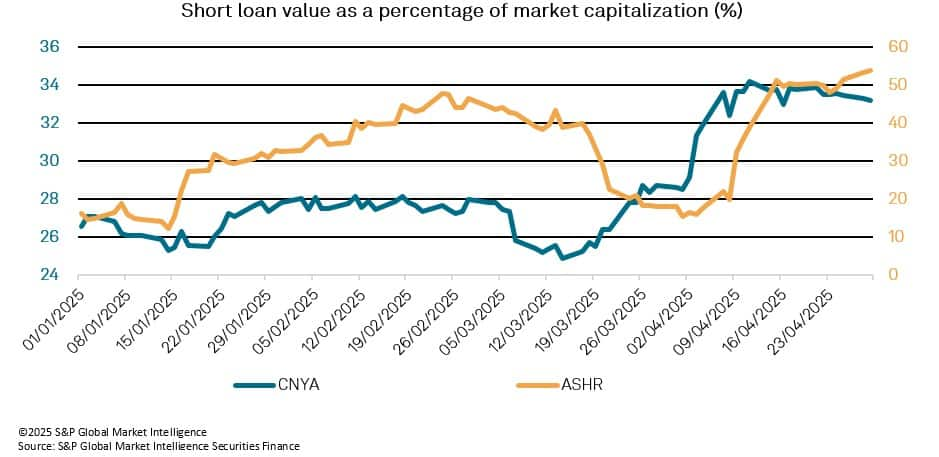Customer Logins
Obtain the data you need to make the most informed decisions by accessing our extensive portfolio of information, analytics, and expertise. Sign in to the product or service center of your choice.
Customer Logins
EQUITIES COMMENTARY
Apr 30, 2025
Tariff-ic Times: Borrowing in Chinese ETFs surges.
ETF investors are increasingly borrowing funds like the iShares MSCI China A UCITS (CNYA) and Xtracker Harvest CSI 300 (ASHR) to capitalize on market volatility.
Recent developments in the trade relationship between the United States and China have sparked significant interest among investors and securities lending market participants. With tariffs soaring to unprecedented levels—145% on Chinese goods and 125% on US products—market volatility has become the norm. This environment has led to increased borrowing activity in ETFs such as the iShares MSCI China A UCITS (USD) (Acc) ETF (CNYA) and the Xtracker Harvest CSI 300 China A Shares ETF (ASHR).

The Impact of Tariffs on Investment Sentiment
The escalating trade tensions between the US and China have created a landscape fraught with uncertainty. High tariffs are not only affecting trade volumes but are also contributing to significant shifts in investor sentiment. As companies brace for the economic fallout—predicted to cost China millions of jobs—US retailers are warning of potential product shortages. Amid this climate of uncertainty, numerous ETF investors have reevaluated their strategies, leading to significant outflows from the Xtracker Harvest CSI 300 China A Shares ETF, while the iShares MSCI China A UCITS ETF has seen no money flow in or out. Specifically, inflows into CNYA have remained at zero for the entire month of April up to April 28th, while ASHR has experienced an outflow of $800 million during the same timeframe, according to data from S&P Global Market Intelligence.
While outflows may signal caution, they have also coincided with an uptick in securities lending activity. Investors are increasingly borrowing these ETFs to take advantage of market volatility, which has created opportunities for profit in a tumultuous environment. The ability to leverage positions through borrowing can amplify potential returns, especially when investors anticipate a rebound in specific sectors or overall market recovery.
Capitalizing on Market Volatility
In times of heightened market volatility, investors seek to capitalize on price fluctuations. Current trade tensions have created a scenario where significant price swings are likely, driven by tariff announcements and shifts in trade policy. For ETF investors, this presents an opportunity to borrow shares and enhance their positions, benefiting from both upward and downward market movements. The iShares MSCI China A UCITS (CNYA) ETF and the Xtracker Harvest CSI 300 China A Shares (ASHR) ETF provide exposure to a diverse range of Chinese equities, making them attractive options for hedging against risks in existing portfolios.
Selective Exemptions: A Silver Lining?
Amid the tariff chaos, China has exempted certain US goods from new tariffs, including pharmaceuticals and microchips. This strategic approach may offer hope for investors, as companies in these sectors could benefit from reduced tariff burdens, prompting borrowing in anticipation of better performance. Such selective exemptions indicate that not all sectors will be equally affected by tariffs, increasing borrowing activity as investors position themselves for potential rebounds.
Long-term Growth Potential Amid Short-term Pressures
Despite immediate challenges posed by tariffs, many investors believe in the long-term growth potential of the Chinese economy. Temporary dips in stock prices may present attractive buying opportunities. By borrowing ETFs, investors can take advantage of these price dips while maintaining liquidity, positioning for future growth. While trade tensions may cause short-term pain, some investors may recognize the potential for recovery and growth, driving borrowing activity to enhance their portfolios.
Speculation and Strategic Positioning
The lack of formal negotiations on tariffs has led to speculation about potential resolutions. Investors may borrow these ETFs to position for positive developments, hoping to capitalize on a rebound in the Chinese market. This speculative behavior is a hallmark of securities lending, where investors seek to amplify their exposure during uncertain times.
Final Thoughts
As the trade relationship between the US and China continues to evolve, ETF investors and securities lending market participants must navigate a complex landscape of uncertainty and opportunity. While both the iShares MSCI China A UCITS ETF (CNYA) and the Xtracker Harvest CSI 300 China A Shares (ASHR) ETF have experienced outflows in recent weeks, the increase in borrowing activity underscores the potential for profit in a volatile market.
Investors are keenly aware of the implications of trade tariffs, selective exemptions, and the long-term growth potential of the Chinese economy. By leveraging these insights, they can strategically position themselves to benefit from the ongoing market dynamics, making informed decisions in an ever-changing environment.
In this climate of trade tensions and market volatility, the rise of ETF borrowing is a trend that will likely continue as investors seek to navigate the complexities of the global economy.
S&P Global provides industry-leading data, software and technology platforms and managed services to tackle some of the most difficult challenges in financial markets. We help our customers better understand complicated markets, reduce risk, operate more efficiently and comply with financial regulation.
This article was published by S&P Global Market Intelligence and not by S&P Global Ratings, which is a separately managed division of S&P Global.
{"items" : [
{"name":"share","enabled":true,"desc":"<strong>Share</strong>","mobdesc":"Share","options":[ {"name":"facebook","url":"https://www.facebook.com/sharer.php?u=http%3a%2f%2fprod.azure.ihsmarkit.com%2fmarketintelligence%2fen%2fmi%2fresearch-analysis%2ftariffic-times-borrowing-in-chinese-etfs-surges-.html","enabled":true},{"name":"twitter","url":"https://twitter.com/intent/tweet?url=http%3a%2f%2fprod.azure.ihsmarkit.com%2fmarketintelligence%2fen%2fmi%2fresearch-analysis%2ftariffic-times-borrowing-in-chinese-etfs-surges-.html&text=Tariff-ic+Times%3a+Borrowing+in+Chinese+ETFs+surges.++%7c+S%26P+Global+","enabled":true},{"name":"linkedin","url":"https://www.linkedin.com/sharing/share-offsite/?url=http%3a%2f%2fprod.azure.ihsmarkit.com%2fmarketintelligence%2fen%2fmi%2fresearch-analysis%2ftariffic-times-borrowing-in-chinese-etfs-surges-.html","enabled":true},{"name":"email","url":"?subject=Tariff-ic Times: Borrowing in Chinese ETFs surges. | S&P Global &body=http%3a%2f%2fprod.azure.ihsmarkit.com%2fmarketintelligence%2fen%2fmi%2fresearch-analysis%2ftariffic-times-borrowing-in-chinese-etfs-surges-.html","enabled":true},{"name":"whatsapp","url":"https://api.whatsapp.com/send?text=Tariff-ic+Times%3a+Borrowing+in+Chinese+ETFs+surges.++%7c+S%26P+Global+ http%3a%2f%2fprod.azure.ihsmarkit.com%2fmarketintelligence%2fen%2fmi%2fresearch-analysis%2ftariffic-times-borrowing-in-chinese-etfs-surges-.html","enabled":true}]}, {"name":"rtt","enabled":true,"mobdesc":"Top"}
]}




